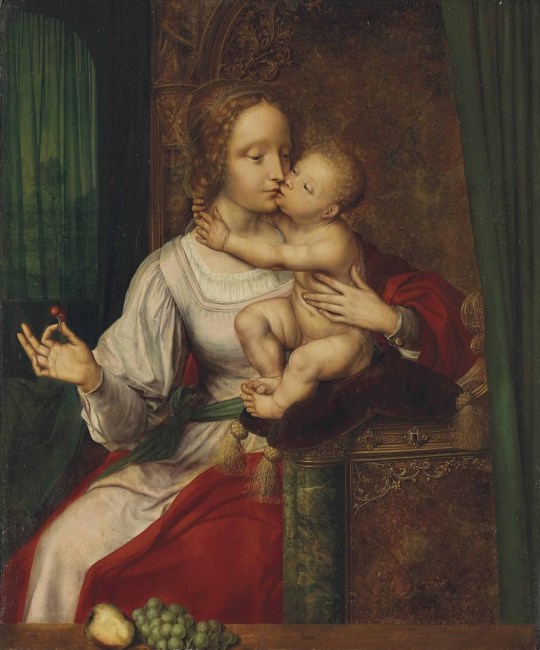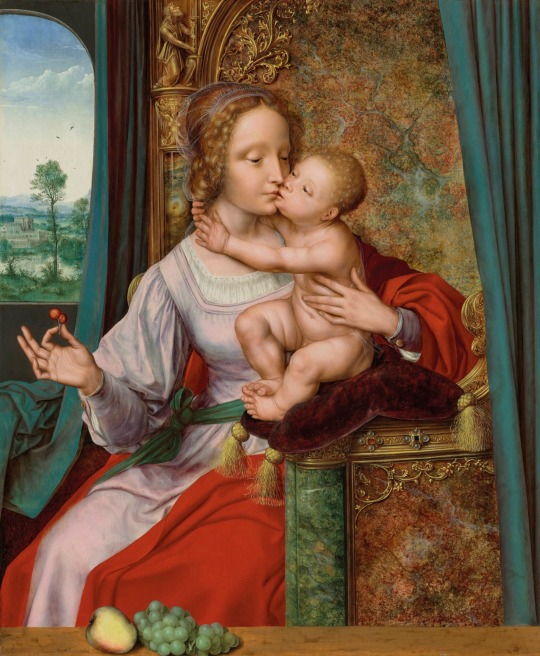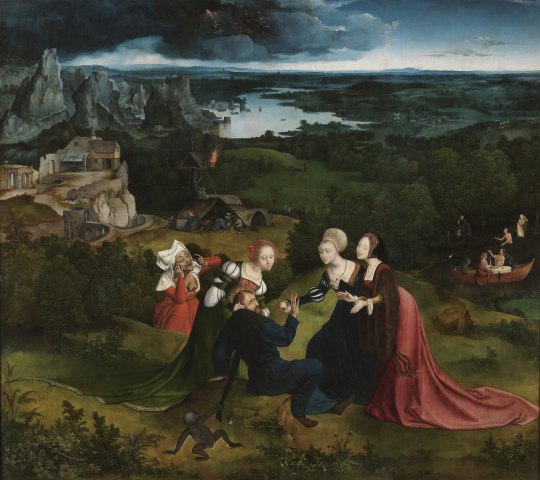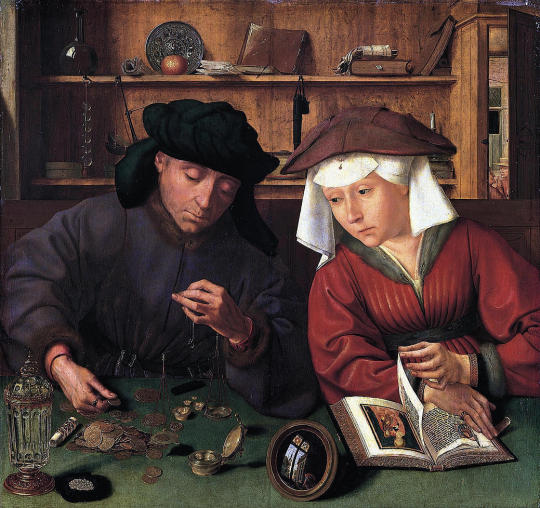#Quentin Metsys
Explore tagged Tumblr posts
Photo

Quentin Metsys (1466-1530) Virgin In Prayer (43 by 31 cm)
15 notes
·
View notes
Text

The Madonna of the Cherries, Quentin Metsys
49 notes
·
View notes
Photo



Quentin Metsys (1466–1530) — details from The Adoration of the Magi, 1526.
This intentionally claustrophobic composition is characteristic of the Antwerp Mannerist style of the first half of the sixteenth century. The scene is viewed up close, with half-length, gesticulating figures separated from the viewer by a fictive ledge. Finely wrought goldsmith work—such as was actually produced for the opulent taste of the cosmopolitan community in Antwerp—abounds.
135 notes
·
View notes
Text

Quentin Metsys: Un coengo (ca. 1525)
5 notes
·
View notes
Text

Madonna and Child / Adoration of the Shepherds
William-Adolphe Bouguereau (1899)
William Dyce (1845)
Carlo Crivelli (1480)
Quentin Metsys (1520s)
Peter Paul Rubens (1609)
Palau, Christmas 2004
#Catholic#Christian#Christianity#philately#Christmas#stamps#Palau#art#sacred art#paintings#William-Adolphe Bouguereau#William Dyce#Carlo Crivelli#Quentin Metsys#Peter Paul Rubens#2004
0 notes
Text

The Money Lender and His Wife (1514 - detail) ✣ Quentin Metsys
0 notes
Text


Quentin Metsys' Madonna of the Cherries was the most celebrated painting in 16th century Antwerp. After cleaning and removal of some clunky additions, this painting went from being considered one of a dozen copies to being recognized as the long-lost original. A 30-50x glowup.
0 notes
Text

Sublime Art.
Quentin Metsys, The Madonna of the Cherries, 1520.
1 note
·
View note
Text

Quinten Metsys
#quinten metsys#quentin massys#christ#art#artwork#fine art#fineart#painting#art history#history of art
42 notes
·
View notes
Text

Quentin Metsys (Flammish, 1466-1530)
Crazy with a spoon, N/D
Oil on canvas
58 notes
·
View notes
Text
Shrouded in Darkness
CHAPTER 4 : PARMIGIANA
previous chapter | next chapter
Will Graham x AFAB character x Hannibal Lecter (Polyamory)
Summary:
In the heart of Baltimore, forensic analyst Sidonie Renard navigates the shadows of crime scenes, concealing her loneliness behind a composed facade. Drawn into a web of intrigue, she captures the attention of profiler Will Graham and the enigmatic Hannibal Lecter.
Word count: 3,2k
Chapter Warning: Murder, Blood, Gore.

Sidonie observed the man in front of her. He was tall and slender, with a lean, angular face. His blue shirt, brown tie, and colorful ornaments on his tie complemented his suit. His hair was styled neatly, giving him a sophisticated look. He was charismatic, well-mannered, and attractive.
“I’m honored to offer any insight I can,” he said to Jack, then turned his attention to the brunette. His eyes took on her appearance.
She was neatly dressed in classic trousers, leather-heeled boots, and a black turtleneck. Her outfit made her large olive-green eyes stand out.
“It’s a pleasure to meet you. Jack speaks highly of you. I’m glad to work with someone of your caliber.” He maintained eye contact.
“The feeling is mutual. You’re also well-known around here. Agent Crawford seems to trust you a lot.” She nodded and smiled slightly, holding her hands in front of her as she glanced at Jack, who gestured for them to sit.
Jack cleared his throat, mentioning that Alana would join them soon.
“Abigail Hobbs woke up this morning. I thought we could consult two professionals before taking action since Miss Renard seemed hesitant about the idea.” Hannibal tilted his head slightly.
“What is the idea you speak of?”
“I have seven families waiting for an answer. I want Miss Renard to consult Abigail and find evidence of what is left of these girls. Speaking to Abigail will be necessary for trust.”
“I’m sure we need to give Abigail some time to process what happened,” Sidonie said.
“Sudden intrusion will only make her more cautious. It’s best if she speaks with her therapist for the first couple of days.”
Jack looked at Hannibal.
“As you can see, she is hesitant.”
“Hesitance isn’t the issue here, Agent Crawford. What you’re asking of me isn’t in my expertise. It’s a huge responsibility to consult a victim while trying to find evidence on them.”
“She might not be a victim at all,” Jack pressed.
“Her father slit her throat, and she nearly died,” Sidonie said, frowning. “She deserves some time to recover.”
Hannibal’s lips curl into a faint smile as if he’s trying not to show his amusement.
“I agree with Miss Renard,” Hannibal said calmly, looking at Jack. “It’s best to stay patient. We don’t want to rush.” He turns to Sidonie. “Combining her expertise while carefully observing Abigail could benefit the case. It might help move things along.” He notices Jack’s pleased expression. “However, given Miss Renard’s limited experience in this area, it’s better if those who have interacted with Abigail stay by her side.”
“Are you suggesting to accompany Miss Renard?” Jack asks.
“I believe it will be the best approach.”
“And what about Will Graham?”
“It’s best if he is there too.”
Sidonie holds her breath, dreading the possible reaction from the men.
“There’s a chance he might not be happy with this idea,” Jack reminds him.
“I expected such a response,” Hannibal replies.
The room falls silent. Jack sighed, realizing he could rely on Hannibal to manage the situation.
“Now, let’s move on to the painter’s case,” Jack stands up and looking at the wall covered with crime scene photos.
Hannibal and Sidonie also rise, with Hannibal holding back to let Sidonie go first. They approach the wall as Jack begins to speak.
“Seven deadly sins. That’s the theme behind the crimes. The number seven indicates the next possible cases, including this one. We have very little evidence of who the killer is, but…” Jack looks at Sidonie. “Miss Renard found a bristle and suggesting he might be a painter.”
“Quentin Metsys, the moneylender, and his wife,” Hannibal says with a slight smile. “A representation of greed.”
“At first, we thought it might be a copycat,” Jack continues, “but that theory was dismissed.”
“Understandable,” Sidonie adds. “A copycat sees himself as superior to his victims. This killer, however, seems to feel undervalued. A copycat is meticulous and proud of his work.”
“Are you familiar with profiling, Miss Renard?” Hannibal asks, intrigued. Sidonie shakes her head.
“No, not really. I just took into account what Mr. Graham said about the case. But over time, you start noticing patterns between evidence and the traits of the criminals.”
“Are you suggesting that evidence itself has character?”
“Not exactly,” Sidonie replies. “But there might be a connection between the evidence and the killer’s traits.”
Hannibal considers her words thoughtfully.
“Do you have any ideas about the killer, Dr. Lecter?” Jack asks. Hannibal turns back to him.
“There’s a chance he may not be a painter after all.”
“Why’s that?” Jack inquires.
“Being a painter is a well-known profession. If he was working as a painter, it would be easier for him to be identified, especially if he was dealing with recent frustrations.”
“And what makes you think that?” Jack asks.
“The statement he’s making.” Sidonie looks frustrated, trying to think of other possibilities. Hannibal’s point about the painter’s potential exposure makes sense. “The choice of the seven deadly sins isn’t random. It shows his inner conflict, his struggle with his own failures, and the wrongs he feels he has faced. He might be revealing something about his own life. There’s more to his story that he wants to share.”
“Well, we need to catch him before he can tell us more,” Jack insists.
The door opened automatically as she stepped outside, her boots clicking as she walked to a bench and sat down. She sighed, rubbing her slightly sweaty hands together. The contrast between the hot office and the cool air outside was noticeable.
She looked at her thumb, watching the sweat mix with her palm.
“Miss Renard, are you okay?”
She looked up, startled by Hannibal’s sudden presence. “Yes, I just needed some fresh air. It’s much cooler out here than in the office.” She wiped her hands on her trousers and moved slightly to make room for him.
Hannibal sat beside her, crossing his legs.
“Do you tend to run hot?” he asked.
“Quite the opposite, actually,” she replied. Hannibal nodded, recalling how cold the room had been earlier. He looked around.
“You mentioned earlier that evidence might link a killer to their traits. What about a painter? What traits might fit him?”
“Will Graham has already covered that. I have nothing new to add,”
“And what about Abigail Hobbs? Is there any evidence that could suggest she’s guilty?”
Her gaze lingered on his face, curious about the sudden change in topic.
“There’s a chance she could be, considering the nature of the crimes. But right now, the only clues would be in her current behavior, which I’m not sure I can help with.”
Hannibal nodded, clearly unsatisfied with her response. It didn’t provide him any new insight, personal or professional.
As his eyes drifted to her hands, he observed how her fingers were intertwined. He saw a scar running from her middle finger down her hand. Recalling the article Freddie Lounds had written about her, it seemed obvious to him why she seemed so anxious earlier.
“Your approach to her seems sympathetic. Some might even call it kind.”
“I’d describe it as flexible, rather than kind.” She looked away, her gaze falling on two familiar figures approaching from a car. “Approaching her right now might be overwhelming, especially after what she’s been through. Whether she’s guilty or not, it’s tough for anyone.”
Hannibal followed her gaze, seeing Alana and Will approaching.
“Balancing empathy with objectivity is no easy task, and you handle it with a rare skill,” Hannibal said. Sidonie blinked at his compliment. He smiled subtly at her reaction.
Will and Alana reached them, and Sidonie and Hannibal stood up.
“I’m glad we’re not too late, Has Jack arrived?”
“We’ve already spoken with Jack,” Hannibal replied.
“So we’re late,” she mumbled.
Noticing Will’s gaze, Hannibal turned to him.
“I assume you know Abigail has woken up?”
“Heard of it,” Will said sarcastically.
“And I assume he wanted to interview her right away,” Alana predicted, raising her eyebrows.
“I won’t argue with that,” Hannibal smirked. Alana shook her head at his response. “Miss Renard suggested we wait before talking to her, which seemed like a wise course of action.”
Hannibal looked at Sidonie, drawing her into the conversation. Alana smiled.
“I’m glad someone agrees with me,” Sidonie nods, smiling slightly.
“Shall we go in?” Hannibal asked Alana, who nodded in response. They headed inside while Will stayed behind.
Sidonie noticed that Will didn’t move, adding to her unease from their earlier shared eye contact.
As the door closed, Will looked around, finding the area empty.
“Jack has involved you in this case, after all,” he mumbled, catching himself. He realized his words might sound unpleasant despite his intention to start a conversation.
“I understand you’re not thrilled about this. But whatever Jack has assigned to me doesn’t reflect on your professionalism,” Sidonie replied.
Will chuckled, almost painfully.
“He doubts my judgment, that’s what it is.”
Sidonie remained silent as she shared the same concern.
“He doubts anyone who disagrees with him,” she pointed. “He strongly believes Abigail was involved.”
“What do you believe in?”
Sidonie blinked in surprise at his question. After a second, she turned to him.
“I trust the evidence, which suggests she wasn’t involved. I won’t rush to judge Abigail Hobbs just because of her father.”
Will looked at her face and saw no signs of deceit or falsehood. She appeared confident and sincere.
Noticing his steady gaze, Sidonie stepped away.
“I need to get back to work.”
Will stared at the road ahead as he and Hannibal drove to the psychiatric hospital to visit Abigail Hobbs, who had woken up a few days ago.
Surprisingly, Jack had taken Sidonie’s advice, and Alana had been persistent about giving the young girl her space.
Will felt a mix of nerves and guilt. He wasn’t just troubled about talking to Abigail; he felt bad for leaving her orphaned, even though he didn’t regret what he did to her father.
He remembered how Garet Jacob Hobbs had looked as life left his eyes, and he was relieved that Abigail hadn’t met the same fate.
Hannibal, who was driving, broke the silence.
“Something on your mind, Will?” Will rubbed his face. “You’re not sure what to say to her.”
“Are you?”
“No,” Hannibal replied, “but our best approach is to stay by her side and help her open up over time.”
“I’m not sure she’ll feel safe around me.”
“You saved her life,” Hannibal reminded him.
“You did,” Will countered.
Hannibal thought for a moment and then said calmly.
“We both played a part. What matters is that she knows she’s not alone. Building trust takes time, and your presence will help her feel safer.”
“What if my presence does the opposite?”
“Your empathy, though it might be a burden to you, can help bridge the gap to her healing. She needs to see that someone understands her pain, even if she doesn’t recognize it yet.”
Will sighed, feeling the weight of Hannibal’s words.
As the car stopped, Will and Hannibal entered the hospital and asked to see Abigail. To their surprise, the nurse told them she already had a visitor. They exchanged a puzzled glance, as the only people who knew Abigail’s location were the FBI and Alana, who they were sure weren’t there.
“Can you describe the person visiting her?” Will asked.
“A short woman with long curly red hair and blue eyes. She’s neatly dressed.” The nurse replied.“
Will frowned in confusion and asked the nurse to lead them to Abigail’s room. When they opened the door, they saw the red-haired woman sitting on Abigail’s bed, talking to her.
“...Works for the FBI but isn’t really an FBI agent. He catches insane men because he can think like them. Because he is insane,” Freddie Lounse said, looking at them.
Will immediately recognized her by her manner of speech.
“Would you excuse us, please?” Will irritate. Freddie stood up as he approached Abigail’s bed. Abigail looked around the room with confusion in her blue eyes. “I’m Special Agent Will Graham,” he introduced himself.
“By Special Agent, he means not really an agent. He didn’t pass the screening. Too unstable,” Freddie looked at Will.
“I insist that you leave the room,” Hannibal interjected. Freddie pulled out her card.
“If you want to talk—”
Will snatched the card from her without saying a word. Freddie didn’t resist and left the room. Abigail looked between the two men as Will removed his glasses and wiped them.
“Abigail, this is Dr. Lecter,” he introduced. After a pause, he asked if she remembered them.
Abigail turned her gaze to Will.
“I remember you. You killed my dad.”
Will nodded, his jaw tightening slightly.
“You’ve been in bed for days, Abigail. How about we take a walk?” Hannibal suggested.
Abigail walked weakly into the garden, supported by Hannibal and Will.
“I’m sorry we couldn’t save your mother. We did everything we could, but she was already gone.” Will said softly.
“I know. I saw him kill her.” Abigail replied, tears stinging her eyes but not falling. They helped her sit down. “He was loving right up until the second he wasn’t. He kept telling me he was sorry and to just hold still.” She stops “He was going to make it all go away.”
“There was plenty wrong with your father, Abigail, but there’s nothing wrong with you.” Will looks at her. “You said he was loving. I believe it. That’s what you brought out in him.”
Abigail fell silent.
“It’s not all I brought out in him,” she whispered, looking at Will. “I’m going to be messed up, aren’t I? I’m worried about nightmares.”
Will didn’t respond. He couldn’t promise her she would be okay or that she wouldn’t be affected.
“We’ll help you with the nightmares,” Hannibal reassured her.
“There’s no such thing as getting used to what you experienced. It bothers me a lot. I worry about nightmares, too.” Will admitted as he sits down next to her.
“So killing somebody, even if you have to do it, it feels that bad?” she inquires.
Hannibal looks at Will, curious how honest his answer will be.
“It’s… The ugliest thing in the world.” Will says carefully as Abigail takes his words in.
“I want to go home,” she whispers.
Freddie Lounds leaned on the hood of Hannibal’s dark blue Bentley, waiting. When she saw Hannibal and Will approaching, she quickly stood up, almost respectfully.
“Special Agent Graham, I never formally introduced myself. I’m Freddie Lounds.” She offered her hand. Will put on his glasses, ignoring her hand.
“Are you trying to salvage this joke from the mouth of madness?”
“Please. Let me apologize for my behavior there. It was sloppy and misguided. And hurtful.”
“Miss Lounds now isn’t the time,” Hannibal spoke. Freddie looked at Hannibal but continued speaking to Will.
“Look, you and I may have our own reasons for being here, but I also think we both genuinely care what happens to Abigail Hobbs.”
“You told her I was insane,” he hissed.
“You weren’t the only topic in the article,” Freddie defended herself, noticing Will’s clenched jaw. “I can undo what I said.” Will tried not to laugh at how absurd she sounded.
“You help Abigail see me as more than her father’s killer and I help you with online ad sales?”
“I can un-do what I said. I can also make it a lot worse.” Freddie warned. Will’s face twitched as he stepped closer to her.
“Miss Lounds, it’s not very smart to piss off a guy who thinks about killing people for a living.”
Sidonie sat at her desk, working on a sample from the corpse. Jimmy clicked his tongue in frustration, and Beverly raised an eyebrow.
“What’s up?” she asked.
“Another article about Will Graham by We All Know Who,” He chanted. Almost everyone gathered around to look at the article on the computer.
Sidonie stayed at her desk, shaking her head slightly. She knew that no one, not even Jack, could stop her from writing nasty articles.
“It’s not very smart to piss off a guy who thinks about killing people for a living.” Jack sits behind his desk reading off of his computer screen “You know what else isn’t very smart?” he looks at Hannibal, who sits next to Will. “You were there with him and you let those words come out of his mouth.”
Alana glanced at the two men next to her, and Sidonie did the same.
“I trust Will to speak for himself,” Hannibal clarified.
“Evidently, you shouldn’t.” Jack replied.
“I’m just happy the story wasn’t about Abigail Hobbs,” Alana said with a slight shrug..
“Then it’s a victory.” Jack pressed his lips together and nodded. “So Abigail Hobbs wants to go home. Let’s take her home.”
“What Abigail wants and what she needs are two different things. Taking her out of a controlled environment would be reckless.” Alana defends.
“You said she was practical.”
“That could just mean she has a dissociative disorder,” Will adds in.
“You take her home, she may experience intense emotions, and respond aggressively. Or reenact some aspect of the traumatic event without even realizing it.” Alana worried as Jack glanced at Hannibal, knowingly.
“Where do you weigh in on this, Doctor?”
“Doctor Bloom is right, but there is a scenario where revisiting the trauma event could help Abigail heal and prevent denial.” Alana shook her head and looked at Sidonie, who was quietly observing the discussion.
“Then we have a difference of opinion. Therefore I’m choosing the opinion that best serves my agenda.” Jack looked at Will. “I want to know if you are right about our Copy Cat Will.”
Will, looked tired, almost asleep.
“We have no way of knowing what’s waiting for her when she goes home,” Alana points out.
“And the publicity might make things worse. The whole city knows about her and her father because of Freddie Lounds.”
“Miss Renard has dealt with Freddie Lounds before. I’m sure she can talk to Abigail about it.” Jack asserts.
“I should add ‘Public Relations Expert’ to my resume,” Sidonie snarked with a slight smile. “I feel like I deserve a raise.”
“Perhaps a comic would be a better choice.” Jack retorts at the comment.
“A shared experience can help Abigail deal with her situation, but Miss Renard isn’t qualified to question her,” Alana argues.
“Hannibal and Will will accompany her as she works on the case.”
“It seems I don’t have a say in this,” Alana’s tone was sharp with frustration.
“No, not on this one,” Jack confirmed.
The room fell silent.
“I think Jack’s right,” Will spoke up, recalling what Hannibal had said on the way to the hospital. “Having someone who’s been through a similar ordeal could help Abigail. It might bring her some… normalcy and comfort.” Hannibal looks at Will, somehow amused at his agreement. He looks at Sidonie, who also seems to be taken aback by his words. “Maybe she can make things easier for everyone…”
Sidonie and Will lock eyes for a moment, their gaze sharing a sense of understanding, or knowing, like back in the pharmacy.
Hannibal observed the moment between Sidonie and Will with curiosity.
“Well, I have to admit, Will, I didn’t see this coming,” Jack says with a tone of genuine surprise as they break eye contact. “But I’m glad you’re on board.”
“So what’s the plan?” Alana asked.
Jack turned to Sidonie.
“Get ready for the trip. We are taking Abigail Hobbs to her nest.”
#nbc hannibal#nbc hannibal fanfiction#hannibal x oc#hannibal lecter x oc#hannibal x reader#hannibal lecter x reader#hannibal x will#hannibal lecter x will graham#will graham x oc#will x reader#will graham x reader#will graham x hannibal lecter#will graham x reader x Hannibal lecter#will graham x oc x hannibal lecter#will x hannibal#will graham#hannibal lecter#original character#original female character#polyamory#canon divergence
37 notes
·
View notes
Text

"Virgin in Adoration", touched by the Clayshaper
Original piece by Quentin Metsys (1466–1530)
54 notes
·
View notes
Text

Quentin Metsys & Joachim Patinir - The Temptations of Saint Anthony the Abbot, c. 1515-22
3 notes
·
View notes
Text






Quentin Metsys (1466-1530)
Portrait of Erasmus of Rotterdam (c1517)
circle of Hans Holbein the younger (1497-1543)
Portrait of Henry VIII (1540)
collection: Palazzi Barberini
(2024)
2 notes
·
View notes
Text

Christ as the Man of Sorrows, about 1520-1525,
Quentin Metsys. Getty Museum
3 notes
·
View notes
Text

MWW Artwork of the Day (9/21/23) Quentin Metsys (Flemish, 1465/66-1530) The Moneylender and his Wife (1514) Oil on panel, 71 x 68 cm. Musée du Louvre, Paris
"The Money-changer and his Wife" is an early example of the genre painting which would flourish in Flanders and the northern Netherlands over the course of the 16th century. Seated behind the table, and each sliced on one side by the frame, the figures are set back from the front edge of the painting. Although sophisticated in their nuances of color, the faces wear an expression of relative indifference. Full of their own life, on the other hand, are the still-life details -- the lavishly illuminated codex through which the wife is leafing, the angled mirror, which reflects the outer world into the picture in masterly foreshortening, and the glass, accessories and coins gleaming on the table and on the shelves against the far wall. In the dominant role which it grants to these objects, the painting marks an important step along the path towards the pure still life.
11 notes
·
View notes